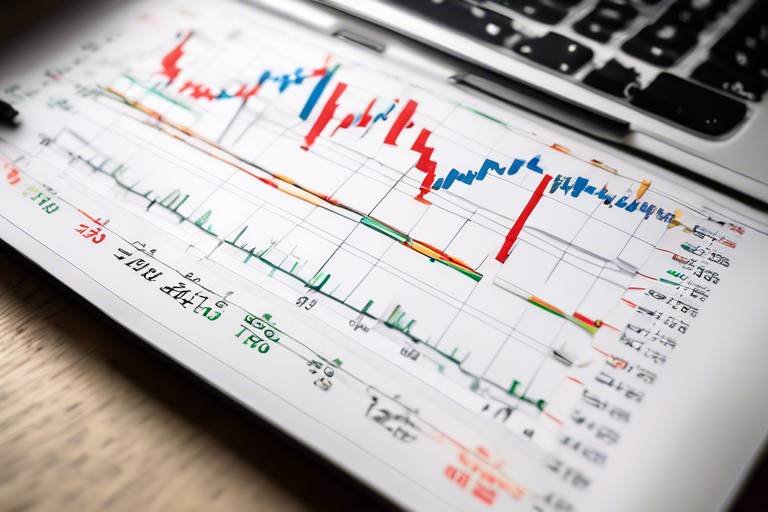How to Read Market Sentiment Using Social Media Trends
In today's fast-paced digital world, understanding market sentiment is more crucial than ever for businesses aiming to stay ahead. Social media has transformed the way we communicate, and it has become a powerful tool for gauging public opinion. By analyzing trends and conversations happening online, companies can tap into the collective voice of consumers, gaining insights that can shape their strategies and influence their decisions. But how can businesses effectively read this sentiment? This article delves into the relationship between social media trends and market sentiment, offering actionable insights for leveraging online conversations to gauge consumer opinions and behaviors.
Understanding market sentiment is not just a nice-to-have; it's a necessity for businesses. It acts as a barometer for consumer confidence, allowing companies to adjust their strategies based on public perception and potential market movements. Think of market sentiment as the weather forecast for your business; just as you wouldn't venture out without checking if it’s sunny or stormy, you shouldn't make significant business decisions without understanding how consumers feel. When sentiment is positive, it can lead to increased sales and brand loyalty. Conversely, negative sentiment can trigger a downward spiral, affecting everything from stock prices to customer retention. Therefore, keeping a finger on the pulse of public opinion is vital.
Social media platforms serve as real-time indicators of public opinion, making them invaluable for businesses looking to understand market sentiment. With millions of users sharing their thoughts and experiences daily, the data generated is immense. By analyzing posts, comments, and shares, businesses can gain valuable insights into consumer sentiment, enabling them to stay ahead of trends and shifts. Social media is like a giant focus group that never sleeps—24/7, people are expressing their likes, dislikes, and emotions. This constant stream of information can be harnessed to identify emerging trends and consumer preferences.
To effectively read market sentiment, businesses must utilize data analytics tools that can process large volumes of social media interactions. These tools help identify patterns and sentiments that influence market behavior. Imagine trying to sift through a mountain of sand to find a few grains of gold; without the right tools, it would be nearly impossible. Similarly, data analytics can help businesses extract meaningful insights from the noise of social media chatter. By employing these tools, businesses can pinpoint what consumers are saying, how they are feeling, and what trends are emerging.
Various techniques, such as natural language processing and machine learning, can be employed to analyze social media data. These technologies extract sentiments and emotions expressed by users, which can inform business strategies. For instance, natural language processing can help decipher the context and sentiment behind a tweet or a Facebook post, allowing businesses to understand not just what is being said, but how it is being said. By leveraging these techniques, businesses can gain a more nuanced understanding of consumer sentiment, enabling them to tailor their marketing efforts effectively.
However, interpreting social media data is not without its challenges. The nuances of language and context can complicate analysis. Businesses must be cautious of misinformation and varying sentiments to ensure accurate analysis. For example, sarcasm or irony can easily be misinterpreted, leading to misguided conclusions. Additionally, the rapid pace at which information spreads on social media can create a distorted view of public sentiment. Therefore, companies need to be equipped with the right tools and expertise to navigate these complexities and ensure their analysis is both accurate and actionable.
Different social media platforms offer unique insights into market sentiment. Understanding the demographics and user behavior on each platform can enhance the effectiveness of sentiment analysis. For instance, Twitter is often used for real-time news and updates, making it an excellent platform for gauging immediate reactions to events. In contrast, Instagram may be more suited for visual sentiment, where users express their feelings through images and stories. By understanding the strengths and weaknesses of each platform, businesses can better tailor their sentiment analysis strategies.
Examining real-world examples of businesses that successfully utilized social media sentiment analysis can provide valuable lessons and strategies for others looking to enhance their market understanding. For instance, a well-known beverage company used sentiment analysis to gauge reactions to a new product launch. By closely monitoring social media conversations, they were able to identify positive feedback and address concerns before they escalated, ultimately leading to a successful product rollout.
Effective sentiment analysis can help businesses manage their brand reputation by identifying potential crises early. By monitoring social media for negative comments or trends, companies can respond promptly to consumer concerns or negative feedback, preventing issues from spiraling out of control. Think of it as a smoke detector for your brand; the earlier you catch a problem, the easier it is to manage.
Influencers play a significant role in shaping market sentiment. Analyzing their social media presence and the sentiments they evoke can provide insights into broader consumer trends and preferences. When an influencer shares a positive experience with a product, their followers are likely to feel the same way, amplifying positive sentiment. Conversely, negative experiences can have a ripple effect, leading to widespread skepticism. Therefore, businesses should not only monitor general sentiment but also pay close attention to the influencers who are shaping that sentiment.
- What is market sentiment? Market sentiment refers to the overall attitude of investors and consumers towards a particular market or product, often influenced by news, trends, and social media.
- How can social media trends affect market sentiment? Social media trends can shape public opinion and consumer behavior, influencing how people perceive brands, products, and services.
- What tools can help analyze social media sentiment? Various analytics tools, such as Hootsuite, Sprout Social, and Brandwatch, can help businesses analyze social media sentiment effectively.
- Why is sentiment analysis important for businesses? Sentiment analysis helps businesses understand consumer opinions, allowing them to make informed decisions, enhance marketing strategies, and manage brand reputation.

The Importance of Market Sentiment
Understanding market sentiment is crucial for businesses aiming to thrive in today's competitive landscape. Why, you ask? Well, market sentiment acts as a mirror reflecting consumer confidence, fears, and expectations. It's like having a pulse on the public's mood, which can significantly influence purchasing decisions and overall market dynamics. When businesses grasp the nuances of market sentiment, they can align their strategies to better meet consumer needs and preferences.
Think of market sentiment as the weather forecast for your business. Just as a sunny day might encourage people to go out and shop, a stormy forecast could send them scurrying indoors. Similarly, positive market sentiment can lead to increased sales and customer loyalty, while negative sentiment can drive potential buyers away. This is why businesses must continuously monitor and interpret these sentiments to stay ahead of their competitors.
Moreover, market sentiment is not just about immediate sales; it also plays a vital role in long-term brand perception. A positive sentiment can enhance brand loyalty and trust, while a negative one can tarnish a brand's reputation almost overnight. Companies that actively engage with their audience and respond to sentiment changes can turn potential crises into opportunities for growth.
To illustrate the significance of market sentiment, consider the following table that outlines key factors influencing consumer behavior:
| Factor | Impact on Market Sentiment |
|---|---|
| Economic Conditions | Positive economic news can boost consumer confidence, while downturns can lead to cautious spending. |
| Brand Reputation | Brands with a strong reputation often enjoy positive sentiment, whereas scandals can lead to swift backlash. |
| Social Trends | Shifts in social attitudes can influence consumer preferences and drive market changes. |
| Influencer Opinions | Endorsements by popular figures can sway public perception and create trends. |
In conclusion, businesses that prioritize understanding market sentiment are better equipped to navigate the complexities of consumer behavior. By leveraging this insight, they can make informed decisions that not only boost sales but also foster long-term relationships with their customers. After all, in a world where opinions can spread like wildfire on social media, being attuned to market sentiment is not just beneficial—it's essential.
- What is market sentiment? Market sentiment refers to the overall attitude of investors and consumers towards a particular market or economic condition.
- How can businesses measure market sentiment? Businesses can measure market sentiment through social media analysis, surveys, and consumer feedback.
- Why is social media important for understanding market sentiment? Social media platforms provide real-time insights into consumer opinions and behaviors, making them invaluable for sentiment analysis.
- What are some challenges in interpreting market sentiment? Challenges include misinformation, language nuances, and the rapid pace of social media conversations.

Social Media as a Sentiment Tool
In today's digital landscape, social media platforms have become powerful tools for gauging market sentiment. They act as real-time barometers of public opinion, capturing the pulse of consumer emotions and behaviors. Think about it: every time someone tweets, posts, or comments, they are sharing their thoughts and feelings, creating a vast pool of data that businesses can tap into. This data is not just noise; it’s a treasure trove of insights that can help companies understand what their customers truly think and feel.
The beauty of using social media as a sentiment tool lies in its accessibility and immediacy. Unlike traditional market research methods, which can take weeks or even months to yield results, social media analysis can provide instant feedback. For instance, if a company launches a new product, they can monitor social media conversations to see how consumers are reacting in real-time. Are people excited? Are they skeptical? This immediate feedback loop allows businesses to pivot quickly and adjust their strategies accordingly.
Moreover, social media platforms have unique characteristics that can influence sentiment analysis. For example, Twitter is often used for quick thoughts and reactions, while Instagram is more visual and can convey emotions through images. Understanding these nuances is essential for businesses looking to decode market sentiment accurately. Here are some key platforms to consider:
- Twitter: Great for real-time reactions and trending topics.
- Facebook: Offers a more in-depth look at consumer interactions and community sentiments.
- Instagram: Visual storytelling that can evoke strong emotional responses.
- LinkedIn: Professional insights and B2B sentiment analysis.
However, while social media offers a wealth of information, it also comes with its challenges. The sheer volume of data can be overwhelming, and not all conversations are relevant or genuine. Businesses must employ advanced analytics tools to filter through the noise and identify meaningful patterns. By utilizing techniques such as sentiment analysis, natural language processing, and machine learning, companies can extract valuable insights from social media interactions. These tools can help classify sentiments as positive, negative, or neutral, providing a clearer picture of consumer attitudes.
In conclusion, social media serves as a dynamic sentiment tool that can significantly influence business strategies. By paying close attention to online conversations, businesses can not only gauge consumer sentiment but also predict market trends and make informed decisions. The key is to stay engaged, be proactive, and leverage the power of social media to enhance understanding of the market landscape.

Analyzing Social Media Data
In today's digital age, social media data analysis has become an essential tool for businesses aiming to stay ahead of the competition. With billions of users generating content every day, the sheer volume of posts, comments, shares, and likes can be overwhelming. However, this data is a goldmine for understanding market sentiment. By analyzing social media interactions, businesses can uncover insights about consumer attitudes, preferences, and behaviors that are often hidden beneath the surface.
To effectively analyze social media data, companies need to employ data analytics tools that can sift through the noise and extract meaningful patterns. These tools utilize various methodologies, including statistical analysis, natural language processing, and machine learning algorithms, to interpret the sentiments expressed in user-generated content. For instance, a company might track mentions of its brand across platforms like Twitter, Instagram, and Facebook, categorizing the sentiments as positive, negative, or neutral.
Here are some key steps involved in analyzing social media data:
- Data Collection: Gather data from various social media platforms using APIs or web scraping techniques.
- Data Cleaning: Remove irrelevant information, such as spam or bots, to ensure the analysis focuses on genuine user sentiment.
- Sentiment Detection: Use natural language processing tools to identify the emotions conveyed in the text, whether they are joy, anger, sadness, or excitement.
- Trend Analysis: Track changes in sentiment over time to identify emerging trends or shifts in consumer behavior.
One of the most exciting aspects of social media data analysis is its ability to provide real-time feedback. Unlike traditional market research methods that can take weeks or even months to yield results, social media analysis allows businesses to gauge public opinion almost instantaneously. This rapid feedback loop enables brands to react quickly to consumer concerns or capitalize on positive sentiment.
Moreover, the demographic data available on social platforms can enhance the analysis. By understanding who is talking about their brand—age, gender, location, and interests—businesses can tailor their marketing strategies to better align with their target audience. For example, if a brand notices a surge in positive sentiment among younger users on TikTok, it may choose to increase its presence on that platform and create content that resonates with that demographic.
However, it's crucial for businesses to remain vigilant about the challenges associated with data interpretation. Social media language can be nuanced; sarcasm, slang, and cultural references can skew sentiment analysis results. Additionally, misinformation can spread rapidly, leading to misguided interpretations of public sentiment. Therefore, companies should constantly refine their analysis techniques and remain adaptable to the ever-evolving landscape of social media.
In conclusion, analyzing social media data is not just about crunching numbers; it's about understanding the human emotions behind those numbers. When done correctly, it can provide invaluable insights that help businesses navigate the complex world of market sentiment.

Sentiment Analysis Techniques
In the ever-evolving landscape of social media, understanding consumer sentiment is akin to having a treasure map that leads to the gold of market insights. To navigate this intricate web of online opinions, businesses can employ a variety of that harness the power of technology. Among the most effective methods are Natural Language Processing (NLP) and Machine Learning (ML), both of which play pivotal roles in deciphering the emotions and attitudes expressed in social media conversations.
Natural Language Processing is a branch of artificial intelligence that enables computers to understand, interpret, and manipulate human language. By using NLP, businesses can analyze vast amounts of text data from social media posts, comments, and reviews. This technique allows for the identification of positive, negative, and neutral sentiments, giving companies a clearer picture of public perception. For instance, if a brand releases a new product, NLP can quickly gauge the online reaction—whether it’s excitement, skepticism, or indifference—helping the brand to tailor its marketing approach accordingly.
On the other hand, Machine Learning algorithms can take sentiment analysis a step further. By training these algorithms on historical data, businesses can predict future consumer behavior based on current trends. For example, if a particular sentiment trend emerges regarding a product category, ML can forecast how that sentiment will evolve, allowing companies to proactively adjust their strategies. This predictive power is invaluable in a marketplace that can shift as rapidly as the latest viral meme.
Moreover, businesses can combine these techniques with data visualization tools to present insights in a more digestible format. Imagine a colorful dashboard that showcases sentiment trends over time, highlighting spikes in negative feedback that may require immediate attention. This visual representation not only makes the data more accessible but also enhances decision-making processes.
However, while these techniques are powerful, they are not without challenges. The nuances of language—such as sarcasm, slang, and cultural references—can complicate sentiment analysis. For example, a post that reads, "Oh great, another product recall!" may appear positive at first glance but is actually laden with frustration. To combat these challenges, businesses should continuously refine their algorithms and incorporate human oversight to ensure accuracy.
In conclusion, leveraging sentiment analysis techniques like NLP and ML can provide businesses with a significant edge in understanding market sentiment. By interpreting the emotional undercurrents of social media conversations, companies can make informed decisions that resonate with their audience. As we dive deeper into the digital age, mastering these tools will be essential for any brand aiming to stay relevant and connected with its consumers.
- What is sentiment analysis?
Sentiment analysis is the process of using natural language processing, text analysis, and computational linguistics to identify and extract subjective information from text data, helping businesses understand public sentiment towards their brand or products.
- How can businesses use sentiment analysis?
Businesses can use sentiment analysis to gauge consumer opinions, manage brand reputation, and tailor marketing strategies based on the emotional responses of their audience.
- What are the challenges of sentiment analysis?
The challenges include interpreting sarcasm, understanding cultural nuances, and ensuring the accuracy of the data being analyzed, which can lead to misinterpretations if not handled carefully.

Challenges in Data Interpretation
Interpreting data from social media can feel like navigating a maze without a map. One of the primary challenges lies in the nuances of language. Social media is a melting pot of slang, emojis, and abbreviations, which can drastically change the meaning of a statement. For instance, a simple phrase like "That’s lit!" can convey excitement in one context, while in another, it might be interpreted as sarcasm. This ambiguity makes it difficult for businesses to accurately gauge sentiment without a deep understanding of the context in which these phrases are used.
Moreover, the sheer volume of data generated on social media platforms can be overwhelming. With millions of posts, tweets, and comments being shared every second, identifying relevant information becomes a Herculean task. Businesses often find themselves drowning in data, struggling to extract meaningful insights. To tackle this, employing advanced analytics tools is essential. These tools can help sift through the noise, but they come with their own set of challenges, such as the need for constant updates to adapt to evolving language trends.
Another significant hurdle is the presence of misinformation. In today’s digital age, false information spreads like wildfire. A single misleading post can skew public perception and lead to incorrect sentiment analysis. Businesses must be vigilant and employ fact-checking mechanisms to ensure that their interpretations are based on accurate data. This is where the importance of context comes into play; understanding the source and the surrounding conversation can help mitigate the effects of misinformation.
Furthermore, varying sentiments can complicate the interpretation process. A product may receive both positive and negative feedback simultaneously, leading to mixed signals. For example, a new smartphone might garner rave reviews for its camera while facing backlash over its battery life. In such cases, businesses must employ sentiment analysis techniques that can dissect these mixed signals to provide a clearer picture of overall consumer sentiment.
Lastly, the ever-changing landscape of social media trends presents a continuous challenge. What is trending today may be forgotten tomorrow. Businesses need to stay agile and adapt their sentiment analysis strategies in real-time to keep pace with these shifts. This often requires a dedicated team that can monitor trends and adjust analyses accordingly, which can be resource-intensive.
In summary, while social media offers a treasure trove of insights into market sentiment, the challenges of data interpretation are significant. From language nuances and misinformation to mixed sentiments and rapidly changing trends, businesses must navigate these obstacles carefully to leverage social media effectively. By employing the right tools and strategies, they can turn these challenges into opportunities for deeper understanding and more informed decision-making.
- What is market sentiment?
Market sentiment refers to the overall attitude of investors and consumers toward a particular market or asset. It can be positive, negative, or neutral, influencing buying and selling decisions.
- How can businesses use social media to gauge market sentiment?
Businesses can analyze social media posts, comments, and trends to understand public opinion, identify emerging trends, and adjust their strategies accordingly.
- What tools are available for sentiment analysis?
There are various tools available, such as Hootsuite, Brandwatch, and Sprout Social, which can help businesses analyze social media data and extract meaningful insights.
- Why is context important in sentiment analysis?
Context helps in accurately interpreting the meaning behind social media posts. Understanding the surrounding conversation and the platform's culture can prevent misinterpretations.

Key Social Media Platforms
When it comes to understanding market sentiment, not all social media platforms are created equal. Each platform has its own unique user base, culture, and communication style, which directly influences the kind of insights businesses can glean from them. For instance, platforms like Twitter are often used for real-time news and updates, making them a hotbed for immediate reactions to market events. On the other hand, Instagram thrives on visual content, which means sentiments expressed there might be more about lifestyle and brand aesthetics rather than direct product feedback.
Moreover, the demographics of each platform play a crucial role in shaping consumer opinions. For example:
- Facebook: With its diverse user base, Facebook allows businesses to engage with a wide range of demographics, making it easier to understand sentiments across different age groups and interests.
- LinkedIn: This platform is more business-oriented, allowing companies to gauge professional sentiments about industry trends, job markets, and corporate reputation.
- TikTok: The younger audience on TikTok often expresses sentiments through creative and entertaining content, which can reveal emerging trends and preferences.
Understanding the nuances of each platform can significantly enhance the effectiveness of sentiment analysis. For instance, a trending hashtag on Twitter might indicate a sudden shift in consumer opinion, while a viral TikTok challenge could signal a new product trend. Businesses that can adapt their strategies based on these insights are more likely to stay ahead of the curve.
In addition, using analytics tools tailored for specific platforms can help businesses dive deeper into the data. For example, tools that specialize in Instagram analytics can provide insights into engagement rates and audience sentiment, while Twitter analytics can track real-time trends and sentiment shifts. By leveraging the right tools, companies can transform raw data into actionable insights that drive strategic decision-making.
Ultimately, the key to successfully reading market sentiment lies in understanding the unique characteristics of each social media platform. By doing so, businesses can tailor their approaches, effectively engage with their audiences, and make informed decisions that align with consumer expectations and behaviors.
Q1: How can I determine which social media platform is best for my business?
A1: The best platform for your business depends on your target audience and the type of content you produce. Consider where your audience spends most of their time and what type of content resonates with them.
Q2: What tools can I use for sentiment analysis on social media?
A2: There are several tools available, including Hootsuite, Brandwatch, and Sprout Social, which can help you analyze social media sentiment effectively.
Q3: How often should I analyze social media sentiment?
A3: Regular analysis is key. Consider conducting sentiment analysis weekly or monthly to stay updated on shifts in consumer opinion and emerging trends.

Case Studies of Successful Sentiment Analysis
When it comes to understanding market sentiment through social media, real-world examples can illuminate the path for businesses eager to tap into consumer opinions. One standout case is that of Coca-Cola, which implemented a robust sentiment analysis strategy to gauge public reaction to their marketing campaigns. By closely monitoring social media chatter during the launch of a new product, Coca-Cola was able to quickly identify both positive and negative sentiments. This immediate feedback loop allowed them to tweak their advertising strategy on the fly, ensuring that they resonated with consumers and addressed any concerns before they escalated.
Another compelling example is Netflix, which utilizes sentiment analysis to inform its content creation strategy. By analyzing tweets, Facebook posts, and other social media interactions, Netflix can discern what genres and themes are currently captivating audiences. This data-driven approach led to the production of hit series like Stranger Things, which was influenced by a surge in nostalgia-driven conversations on social media. By listening to what viewers are saying, Netflix not only boosts viewer engagement but also minimizes the risk of investing in content that might flop.
Let’s not forget about the fashion retailer Zara. Zara employs sentiment analysis to monitor customer feedback across various platforms. By analyzing comments and reviews, they can identify emerging fashion trends and consumer preferences. For instance, if a particular style garners a lot of positive buzz, Zara can quickly ramp up production to meet demand. Conversely, if a product receives negative feedback, they can pivot their strategies to avoid potential losses, demonstrating how sentiment analysis can be a game-changer in fast-paced industries.
These case studies highlight the importance of being proactive rather than reactive. Companies that leverage sentiment analysis effectively can not only enhance their marketing strategies but also improve customer satisfaction and brand loyalty. The key takeaway is that understanding consumer sentiment through social media is not just about collecting data; it's about translating that data into actionable insights that drive business success.
- What is sentiment analysis? Sentiment analysis is the process of determining the emotional tone behind a series of words, used to gain an understanding of the attitudes, opinions, and emotions expressed within an online mention.
- How can businesses use social media sentiment analysis? Businesses can use sentiment analysis to monitor brand reputation, understand customer preferences, and adapt marketing strategies based on consumer feedback.
- What tools can help with sentiment analysis? There are various tools available, such as Hootsuite, Brandwatch, and Sprout Social, which can help businesses track and analyze social media sentiment effectively.
- Are there challenges to sentiment analysis? Yes, challenges include interpreting sarcasm, understanding context, and dealing with misinformation, which can skew the results.

Brand Reputation Management
In today's fast-paced digital landscape, has become more critical than ever. With the rise of social media, consumers have a platform to voice their opinions and experiences, which can significantly impact a brand's image. Imagine your favorite café; if someone posts a glowing review on Instagram, it might encourage others to visit. Conversely, a single negative tweet can send potential customers running in the opposite direction. This duality underscores the importance of monitoring and managing your brand's online presence.
Effective sentiment analysis allows businesses to stay ahead of potential crises. By continuously analyzing social media conversations, companies can identify emerging issues before they escalate. For example, if a product receives a wave of negative feedback, businesses can quickly address the concerns, whether through improved customer service, product adjustments, or public statements. This proactive approach not only mitigates damage but also demonstrates to consumers that the brand values their feedback.
To illustrate the impact of brand reputation management, consider the following table that highlights the potential consequences of neglecting social media sentiment:
| Scenario | Potential Consequence |
|---|---|
| Ignoring negative feedback | Loss of customer trust and loyalty |
| Responding to criticism | Increased customer satisfaction and loyalty |
| Failing to monitor trends | Missed opportunities for improvement |
| Actively engaging with customers | Enhanced brand reputation and consumer relationships |
Moreover, actively engaging with customers on social media can turn a potentially negative experience into a positive one. When brands respond promptly and empathetically to complaints, they not only resolve individual issues but also showcase their commitment to customer satisfaction. This engagement can lead to increased brand loyalty and a stronger reputation in the long run.
In summary, brand reputation management is not just about damage control; it's about building a robust relationship with your audience. By leveraging social media sentiment analysis, businesses can gain valuable insights into consumer perceptions and preferences, allowing them to tailor their strategies accordingly. Remember, in the world of social media, a brand's reputation can change in an instant, making it essential to stay vigilant and responsive.
- What is brand reputation management?
Brand reputation management involves monitoring and influencing how a brand is perceived by the public, especially on social media platforms. - Why is social media important for brand reputation?
Social media allows consumers to share their experiences and opinions in real-time, which can significantly impact a brand's image. - How can I improve my brand's reputation?
Engage with your audience, respond to feedback promptly, and utilize sentiment analysis tools to understand consumer perceptions. - What are the risks of ignoring social media sentiment?
Ignoring social media sentiment can lead to a damaged reputation, loss of customer trust, and missed opportunities for improvement.

Influencer Impact on Sentiment
In today's digital landscape, influencers have become the modern-day trendsetters, wielding significant power over consumer perceptions and behaviors. Their ability to shape market sentiment cannot be underestimated. With millions of followers hanging on their every word, influencers have the unique capacity to sway opinions, ignite discussions, and even shift market dynamics. But how exactly do they do this?
Influencers create a personal connection with their audience, making their endorsements feel more like friendly recommendations rather than traditional advertisements. This authenticity is crucial because consumers are increasingly skeptical of overt marketing tactics. When an influencer shares a product or expresses an opinion about a brand, it resonates deeply with their followers, who often view them as relatable figures rather than distant celebrities. This phenomenon can significantly affect brand perception and consumer trust.
Moreover, the emotional responses elicited by influencers can be profound. For instance, when an influencer shares a heartfelt story or a personal experience related to a product, it can evoke feelings of empathy and connection among their audience. This emotional engagement often translates into heightened brand loyalty and increased sales. To illustrate this point, consider the following table that outlines the types of sentiments typically expressed in influencer marketing:
| Sentiment Type | Description | Impact on Brand |
|---|---|---|
| Positive | Enthusiastic endorsements and praise | Boosts brand reputation and sales |
| Neutral | Informative posts without strong opinions | Increases awareness but less impact on sales |
| Negative | Criticism or unfavorable comparisons | Can damage brand reputation and decrease sales |
Additionally, it's essential to recognize the role of social media platforms in amplifying influencer messages. Each platform offers unique features that can enhance or dilute an influencer's impact. For example, Instagram thrives on visual content, making it ideal for lifestyle influencers showcasing products, while Twitter allows for quick, real-time reactions that can spark viral conversations. Understanding these dynamics is key for businesses looking to leverage influencer marketing effectively.
However, it’s not all sunshine and rainbows. The influencer landscape is fraught with challenges, including the risk of misinformation and the potential for backlash. A poorly received post can lead to a swift decline in consumer sentiment, highlighting the need for brands to choose their influencers wisely. Moreover, as consumers become more aware of influencer marketing tactics, the line between genuine recommendations and paid promotions becomes increasingly blurred. This shift necessitates transparency from influencers to maintain credibility and trust among their followers.
In conclusion, influencers play a pivotal role in shaping market sentiment, acting as catalysts for consumer opinions and behaviors. Their ability to foster emotional connections and drive conversations can lead to significant shifts in brand perception. However, brands must tread carefully, ensuring they collaborate with the right influencers and maintain authenticity in their marketing efforts. By understanding the nuanced relationship between influencers and market sentiment, businesses can better navigate the complex landscape of consumer behavior.
- How do influencers impact consumer purchasing decisions? Influencers can significantly sway purchasing decisions through their endorsements and personal stories, creating a sense of trust and relatability.
- What should brands consider when choosing influencers? Brands should evaluate the influencer's audience demographics, engagement rates, and authenticity to ensure alignment with their target market.
- Can negative influencer sentiment affect a brand? Yes, negative sentiment from influencers can lead to a decline in brand reputation and consumer trust, making it crucial for brands to manage their influencer relationships carefully.
Frequently Asked Questions
- What is market sentiment and why is it important?
Market sentiment refers to the overall attitude of investors and consumers toward a particular market or asset. It's important because it reflects consumer confidence and can influence market movements, helping businesses make informed decisions and adjust their strategies accordingly.
- How can social media help in understanding market sentiment?
Social media acts as a real-time barometer of public opinion. By analyzing posts, comments, and shares, businesses can gain valuable insights into consumer feelings and trends, allowing them to stay ahead of shifts in the market.
- What tools are available for analyzing social media data?
There are various data analytics tools available, such as sentiment analysis software and social listening platforms. These tools can process large volumes of social media interactions, helping identify patterns and sentiments that influence market behavior.
- What techniques are used in sentiment analysis?
Sentiment analysis employs techniques like natural language processing (NLP) and machine learning to extract emotions and sentiments from social media data. These techniques help businesses understand how consumers feel about their brand or products.
- What challenges might businesses face when interpreting social media data?
Interpreting social media data can be tricky due to language nuances, sarcasm, and context. Businesses must also be cautious of misinformation and varying sentiments to ensure their analysis is accurate and reliable.
- Which social media platforms are best for sentiment analysis?
Different platforms provide unique insights. For instance, Twitter is great for real-time trends, while Instagram can showcase visual sentiment. Understanding the demographics and user behavior on each platform enhances the effectiveness of sentiment analysis.
- Can you give examples of successful sentiment analysis?
Many brands have successfully leveraged sentiment analysis to improve their strategies. For example, companies like Nike and Starbucks have used social media insights to manage their brand reputation and respond to consumer feedback quickly.
- How does influencer marketing impact market sentiment?
Influencers can significantly shape market sentiment through their reach and relatability. By analyzing their social media presence and the sentiments they evoke, businesses can gain insights into broader consumer trends and preferences.



















